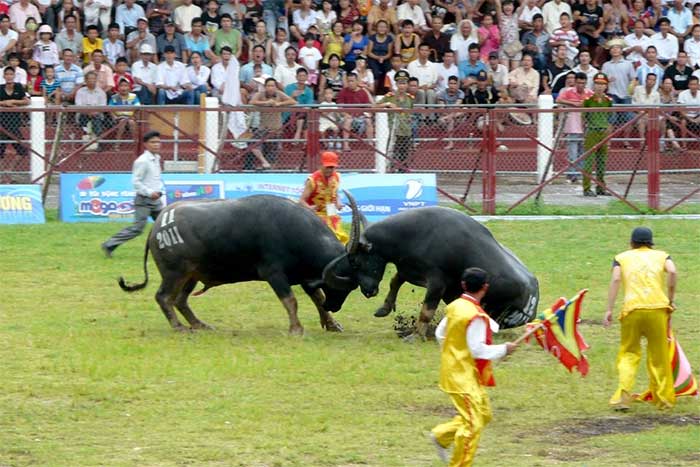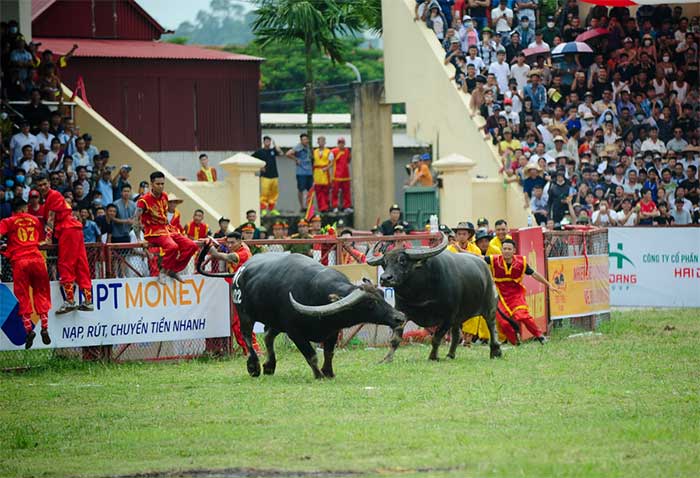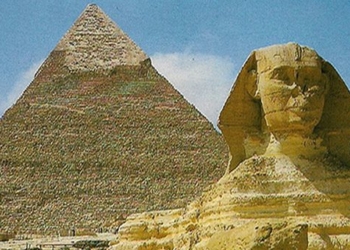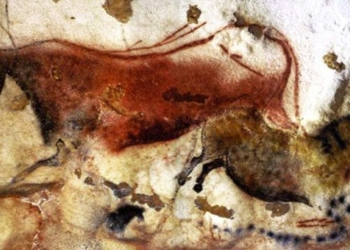The Đồ Sơn Buffalo Fighting Festival, also known as the Bull Fighting Festival, is an ancient tradition that dates back to ancient times, celebrated by the fishing communities in the Đồ Sơn area of Hải Phòng.
The festival takes place annually on the 9th day of the 8th lunar month and was recognized as a national intangible cultural heritage of Vietnam in 2013. It is a festival characterized by solemn rituals, the procession of deities, canopies, and traditional music…
In the cultural heritage of the Hải Phòng community, there is a folk saying: “Regardless of where one trades, on the 9th of the 8th lunar month, come back for the Buffalo Fighting.”
History of the Buffalo Fighting Festival

The festival occurs annually on the 9th of the 8th lunar month.
To this day, the exact history of the festival’s origin has not been determined. The local community shares many stories and legends about the festival, including:
“At the foot of Đồ Sơn Mountain, in Nghi Dương district, there is a shrine dedicated to the Water God. It is said that a local merchant passing by saw two bulls fighting under the shrine, leading to the annual tradition of buffalo fighting on the 9th of the 8th lunar month as an offering to the deity” (According to the Đại Nam nhất thống chí).
The history of the buffalo fighting festival is intertwined with the legend of a beautiful village girl named Đế, who became pregnant by the Water King and was punished by her villagers. Local officials took her to the sea to drown her. Out of grievance, she manifested her spirit, and the local community established a shrine in her honor, called the Shrine of Lady Đế. The site became sacred, attracting fish and shrimp, leading fishing communities to gather there year after year. Eventually, the local community organized the Buffalo Fighting Festival, where the winning bulls were offered to the Lady of the Sea. Some believe that the legend of drowning Lady Đế off Hòn Độc is a remnant of the ancient practice of sacrificing girls to the Water God, which was later replaced by animal sacrifices as society evolved.
In this area, the Đồ Sơn community also remembers the story of a local hero, Quận He Nguyễn Hữu Cầu from Lôi Động village, Tân An commune, Thanh Hà district, who raised the flag against the brutal feudal regime during the period of 1741 – 1751 for the well-being of the fishing community.
To honor this hero, the people of Đồ Sơn hold the Buffalo Fighting Festival and perform flag dances annually. Some documents suggest that: “Whenever he won a battle, he would often slaughter a buffalo to celebrate with his troops. The fighting bulls would break free from their ropes and fiercely battle each other. Soldiers, witnessing this, would cheer loudly. Since then, every year, Nguyễn Hữu Cầu organized the buffalo fighting festival to boost the morale of his soldiers.”
The Buffalo Fighting Festival has two significant days. The first day, the 8th of the 6th lunar month, is dedicated to selecting the best bulls for the finals on the 9th of the 8th lunar month. This period coincides with high tides and strong winds. Furthermore, Đồ Sơn is home to the “Tiềm Thủy Ngưu,” a breed of buffalo found in the submerged areas of the river. Therefore, the buffalo fighting festival serves as an offering to the Water God, praying for favorable winds and calm seas.
Legend of the Giant Fish. Local fishermen recount that they were often preyed upon by giant fish, prompting them to establish a ritual in early June, promising to slaughter buffalo and pigs as an offering. Two months later, during a stormy night, they discovered a dead giant fish the next morning, marked with bird peck marks, believed to be a divine bird sent to protect the people. From then on, the villagers were no longer attacked by the giant fish. As promised, every year, they bring buffalo to the shrine at Nghè. During the ritual, the buffalo would break free and fiercely fight each other. The community believes that the deities enjoy watching the buffalo fights. Thus, the villagers organize the buffalo fighting festival annually, making it a significant event and a traditional celebration for the fishing community.
According to the book “History of the People of Hanoi” by author Hà Ân, the Đồ Sơn Buffalo Fighting Festival may date back to the Trần Dynasty, although there is no concrete evidence.
A Unique Festival of Coastal Inhabitants
The Đồ Sơn Buffalo Fighting Festival represents a fusion of agricultural and coastal cultural elements; it has its own distinct flavor, intertwining the worship of water deities with the rituals of fighting and animal sacrifice. This festival reflects the cultural identity, spirit, and physical resilience of coastal residents who face the sea and storms daily to earn a living.

To prepare, buffalo owners must carefully select and nurture the animals.
While communities elsewhere celebrate their festivals with the saying “Each village has its own drum, and each village has its own deity,” the Đồ Sơn Buffalo Fighting Festival is associated with the tradition of “all villages strike the same drum, all villages worship the same deity” to honor the contributions of the deities, maintain social order, and pray for “peace and prosperity,” thereby reinforcing community spirit and awareness.
Moreover, according to the beliefs of the coastal residents, especially fishermen in the Đồ Sơn area, the image of the moon is closely linked to the tides. The depiction of two bulls fighting under the silvery moonlight in the legend of the Đồ Sơn Buffalo Fighting Festival reflects some connection between the moon and the sea. The horns of the bulls symbolize the crescent moon, associated with the deity Độc Cước, whom coastal residents still worship.
For this reason, in the past, victorious bulls from the festival were taken out to sea and released as offerings to the deities. Later, the winning bulls were paraded with incense burners to the Nghè shrine and carried the “Supreme Deity” flag back to the village, where they were slaughtered as offerings to the village guardian, praying for favorable weather, calm seas, and abundant fishing seasons.
Content of the Festival
Selection, Raising, and Training of Buffaloes
To prepare, buffalo owners must carefully select and nurture the animals for about a year. Typically, after the Lunar New Year, fighting arenas send experienced individuals to purchase buffaloes, sometimes traveling for months to provinces such as Thanh Hóa, Nghệ An, Nam Định, Thái Bình, or even as far as Tuyên Quang and Bắc Kạn to find suitable buffaloes.
The buffaloes must be strong males with a sturdy build, dark skin, and a specific coat pattern. They should have a wide chest, a long and slightly tapered neck, a thick and flat back capable of enduring blows from opponents… These are considered brave buffaloes. The hindquarters must be broad but taper towards the rear, which is highly valued. The horns must be black, curving upwards like two bows, and between the horns, there should be a tuft of hair forming a peak, with circular whorls on the top of the head. The buffalo’s eyes should be dark with red pupils.
Fighting Arena
The fighting arena, or the fighting ground, is typically a large area measuring about 80 x 100 meters, surrounded by a water moat. Inside the moat, there are two platforms for the fighting buffaloes called “xào xá.” Additionally, there are spectator stands for the audience to watch and cheer for the buffaloes.
Festival Activities
The buffalo fighting festival consists of two parts, the ceremonial and the festive, intertwined. From the first day of the month, the village elders conduct a ritual to honor the deity Điểm Tước at the communal shrine. This is followed by a water procession associated with the worship of the Water God. The sacred water vessel is replaced annually by each village.
At the village shrine, buffalo owners present their buffaloes to honor the village guardian, and after the ceremony, the fighting buffaloes are referred to as “Mr. Buffalo.”
On the main festival day, the 9th of the 8th lunar month, around 1 AM, the village priests conduct a ceremony to seek permission from the village guardian to take the buffaloes for competition. Around 6-7 AM, the procession of “Mr. Buffalo” to the fighting arena begins. Leading the procession are musicians, drums, gongs, ceremonial canopies, and offerings. Those carrying the ceremonial canopies and musical instruments wear red scarves and red outfits with yellow trim. The announcer, or the one leading the procession, wears a black robe, a red sash, and white pants. Following them are the elders, dignitaries, and the ranked buffaloes (based on the selection results), adorned with a red cloth and silk ribbons on their horns. Beside each buffalo are two young men holding flags to dance. The procession of “Mr. Buffalo” into the xào xá is lively, accompanied by traditional music and the cheers of the local residents…
As “Mr. Buffalo” enters the xào xá, the sounds of drums and announcements resonate powerfully, echoing like waves crashing against Hòn Độc, where the buffalo will be sacrificed to the Water God.
Next is the ceremonial flag dance, performed by 24 young men from the village, arranged in two lines, showcasing both grace and strength, with vibrant and mystical colors amidst the sounds of drums and gongs; it reenacts the battle preparations of Quận He Nguyễn Hữu Cầu before heading into battle, expressing the wish for the Wind God to bless the fishermen as they brave the waves at sea.
Once the flag dance concludes, two “Mr. Buffaloes” are led into the arena, with individuals holding canopies and dancing with flags on either side. When the two buffaloes are about 20 meters apart, the handlers quickly release the ropes and make a hasty exit from the fighting area. The two buffaloes are then free to charge at each other, vying for victory.
At the end of the festival, the victorious buffalo is ceremoniously paraded back. On the 10th of the 8th lunar month, all buffaloes that participated in the festival are slaughtered as offerings to the deities at the shrine, accompanied by a plate of blood and buffalo fur (mao huyết). The ceremonial offerings begin around noon. Afterward, the blood plate is poured into the sea, and the remaining parts are shared among the villagers as a blessing for a prosperous new fishing season with an abundance of shrimp and fish.
On the 16th of the 8th lunar month, the village conducts the “sending off the deities” ceremony and concludes the festival.





















































